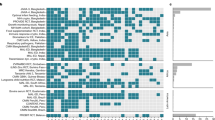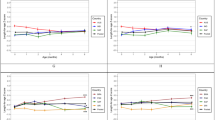Abstract
Background
In view of the ongoing debate on “chronic malnutrition” and the concept of “stunting” as “a better measure than underweight of the cumulative effects of undernutrition and infection (WHO)”, we translate, briefly comment and re-publish three seminal historic papers on catch-up growth following re-feeding after severe food restriction of German children during and after World War I. The observations were published in 1920 and 1922, and appear to be of particular interest to the modern nutritionist.
Results
The papers of Abderhalden (1920) and Bloch (1920) describe German children of all social strata who were born shortly before World War I, and raised in apparently “normal” families. After severe long-standing undernutrition, they participated in an international charity program. They experienced exceptional catch-up growth in height of 3–5 cm within 6–8 weeks. Goldstein (1922) observed 512 orphans and children from underprivileged families. Goldstein described very different growth patterns. These children were much shorter (mean height between −2.0 and −2.8 SDS, modern WHO reference). They mostly failed to catch-up in height, but tended to excessively increase in weight particularly during adolescence.
Conclusion
Whereas Abderhalden and Bloch illustrate rapid height catch-up in children from intact social background, Goldstein’s observations in orphans and children from poor social background parallel the growth patterns observed in children of modern middle and low-income countries. The historic observations question the current concept of stunting as prima facie evidence of malnutrition and chronic infection, and support the view that “the child’s longitudinal growth is largely independent of the extent and nature of the diet”.
This is a preview of subscription content, access via your institution
Access options
Subscribe to this journal
Receive 12 print issues and online access
$259.00 per year
only $21.58 per issue
Buy this article
- Purchase on Springer Link
- Instant access to full article PDF
Prices may be subject to local taxes which are calculated during checkout


Similar content being viewed by others
Notes
For comparing the historic data with modern growth, we referred Goldstein’s data on WHO references. Abderhalden’s children are short and light, but markedly less short than Goldstein’s orphans.
These notes differ from Goldstein’s observations. A similarly marked influence of re-feeding on mood and behavior was not reported in the orphaned children.
Hb values are given in percent of 16 g/dl, i.e., 38% equals Hb of 6.1 g/dl.
This short statement highlights that Bloch’s children were not biased by social deprivation as Goldstein’s proletarians and orphaned children.
This note parallels Goldstein’s observation of poor recovery in orphaned children.
From the middle of the 19th century, Davos became a popular destination for the sick and ailing. Its microclimate in the high valley was deemed excellent and recommended for lung disease patients. Robert Louis Stevenson suffered from tuberculosis, and wintered in Davos in 1880 upon the recommendation of his Edinburgh physician Dr. George Balfour. A sanatorium in Davos is also the inspiration for the Berghof Sanatorium in Thomas Mann’s novel Der Zauberberg (The Magic Mountain).
Bloch describes the decreased immune response that is characteristic after severe starvation.
The psychosocial situation of orphan children and children raised under impoverished conditions is not taken into consideration by Goldstein.
Pirquet’s growth reference chart [12] consists of three parallel columns, for age, height, and weight. Horizontal marking of individual measures indicates average height and weight for age. Upward or downward shifted marks on the parallel columns visually indicate deviation from the average.
BMI_SDS according to modern WHO references illustrate that the loss in body mass of the orphan children is less than the loss in height, and increases with age.
Weight loss of 20% at this age roughly corresponds to a decrease in average weight of −1.3 standard deviations (SD), a weight loss of 33% to a decrease of approximately −2 SD (wasting).
This observation appears essential for the understanding of the differences in the catch-up in height and weight between Goldstein’s orphan children and those observed by Bloch and Abderhalden. In spite of the unfavorable nutritional conditions, weight-for-height of the orphans was less impaired than height.
The term “retardation” refers to average height of a younger age. Children who are short for their chronological age are considered “younger in height”. This terminology was common at the time of Goldstein, and does not refer to biological age, bone age, or any other reference to the state of physical maturity.
Goldstein does not mention social deprivation as a cause of growth impairment.
Goldstein’s explanations are cumbersome. In his days the use of standard deviations and SD scores were not yet introduced. We therefore added height_SDS. In all age groups, Goldstein’s orphan children are almost evenly below −2 SD for height. This is different in BMI. The reduction in BMI becomes greater at early adolescence, and appears to reflect the progressive delay in puberty.
Quakers (or Friends) are members of a Christian group of religious movements formally known as the Religious Society of Friends or Friends Church. When the First World War finished in 1918, and the Armistice came, members of the Friends Ambulance Unit were among the first to enter Germany; http://www.quakersintheworld.org/quakers-in-action/302.
“Neuropathy” hardly plays a role in the modern psychotherapeutic and psychiatric practice. Formerly this diagnosis included psychosomatic illnesses and symptoms of depression and exhaustion.
Goldstein’s observation in orphans and children from poor social background parallel modern observations of the “double burden of malnutrition”, i.e., the co-existence of short stature and obesity [13].
The onset of puberty in the beginning of the 20th century was some 1.5–2 years later than today. Menarche occurred around age 15 years shortly after World War I [14]. This delay in the onset of puberty partially caused the low SD scores for height and BMI in the young adolescents. The delay in developmental tempo was not due to nutrition, it also occurred in the wealthy and well-fed upper social strata at that time [15].
Sandwich (Stulle, Butterbrot) means one slice of mostly dark bread, not toasted, with one layer of butter, topped with some jam, or ham, or cheese. Stulle does not imply multiple layers or lots of fillings as the typical English sandwich. Nevertheless, the amount eaten appears very large!
Goldstein is not aware that orphan children tend to be shorter than children brought up in intact families [16]. In these children, short stature may be viewed as an indicator of psychosocial pressure that continues to exist after re-feeding. The children described by Bloch and Abderhalden were not orphans and already before re-feeding, taller than Goldstein’s children.
This statement contrasts the observations of Bloch and Abderhalden.
Roughly equivalent to −1 to −3 height_SDS.
References
Dickersin K. The existence of publication bias and risk factors for its occurrence. J Am Med Assoc. 1990;263:1385–9.
Dickersin K, Chalmers I. Recognizing, investigating and dealing with incomplete and biased reporting of clinical research: from Francis Bacon to the WHO. J R Soc Med. 2011;104:532–8.
Lundh A, Lexchin J, Mintzes B, Schroll JB, Bero L. Industry sponsorship and research outcome. Cochrane Database Syst Rev. 2017;2:MR000033 https://doi.org/10.1002/14651858.MR000033.
Mandrioli D, Kearns CE, Bero LA. Relationship between research outcomes and risk of bias, study sponsorship, and author financial conflicts of interest in reviews of the effects of artificially sweetened beverages on weight outcomes: a systematic review of reviews. PLoS ONE. 2016;11:e0162198 https://doi.org/10.1371/journal.pone.0162198.
Boutron I, Ravaud P. Misrepresentation and distortion of research in biomedical literature. Proc Natl Acad Sci USA. 2018;115:2613–9.
Hermanussen M, Bogin B, Scheffler C. Stunting, starvation, and refeeding—a review of forgotten 19(th) and early 20(th) century literature. Acta Paediatr. 2018;107:1166–76. https://doi.org/10.1111/apa.14311.
Goldstein F. Klinische Beobachtungen über Gewichts- und Längenwachstum unterernährter schulpflichtige Kinder bei Wiederauffütterung. Zeitschr Kinderheilkd. 1922;32:178–98.
Bloch H. Untersuchung an schwer unterernährten deutschen Kindern. Münchener Med Wochenschr. 1920;37:1062–4.
Abderhalden E. Der Erfolg der Schweizer Fürsorge für Deutsche Kinder. Münchener Med Wochenschr. 1920;67:1444.
Uauy R, Albala C, Kain J. Obesity trends in Latin America: transiting from under- to overweight. J Nutr. 2001;131:893S–9S.
Schlesinger E. Wachstum, Gewicht und Konstitution der Kinder und der heranwachsenden Jugend während des Krieges. Zeitschr Kinderheilkd. 1919;22:80–123.
Pirque CV. Eine einfache Tafel zur Bestimmung von Wächstum und Ernährungszustand bei Kindern. Zeitschr Kinderheilkd. 1913 O. VI: 253–62.
Prentice AM. The double burden of malnutrition in countries passing through the economic transition. Ann Nutr Metab. 2018;72:47–54.
Lehmann A, Scheffler C, Hermanussen M. The variation in age at menarche: an indicator of historic developmental tempo. Anthropol Anz. 2010;68:85–99.
Hermanussen M. Adolescent growth spurt. In: Hermanussen M, editor. Auxology. Studying human growth and development. Stuttgart: Schweizerbart; 2013.
Beegle K, de Weerdt J, Dercon S. Orphanhood and human capital destruction: is there persistence into adulthood? Demography. 2010;47:163–80.
Regulski C. Klippfisch und Steckrüben. Die Lebensmittelversorgung der Einwohner Frankfurts am Main im Ersten Weltkrieg 1914–1918. Wiesbaden/Frankfurt: Kramer; 2012.
Chickering R. Imperial Germany and the Great War, 1914–1918. 3rd ed. Cambridge: Cambridge University Press; 2014.
Acknowledgements
This manuscript was supported by the Auxological Society.
Author information
Authors and Affiliations
Corresponding author
Ethics declarations
Conflict of interest
The authors declare that they have no conflict of interest.
Rights and permissions
About this article
Cite this article
Hermanussen, M., Bilogub, M., Lindl, A.C. et al. Weight and height growth of malnourished school-age children during re-feeding. Three historic studies published shortly after World War I. Eur J Clin Nutr 72, 1603–1619 (2018). https://doi.org/10.1038/s41430-018-0274-z
Received:
Accepted:
Published:
Issue Date:
DOI: https://doi.org/10.1038/s41430-018-0274-z
This article is cited by
-
Stunting is not a synonym of malnutrition
European Journal of Clinical Nutrition (2020)



